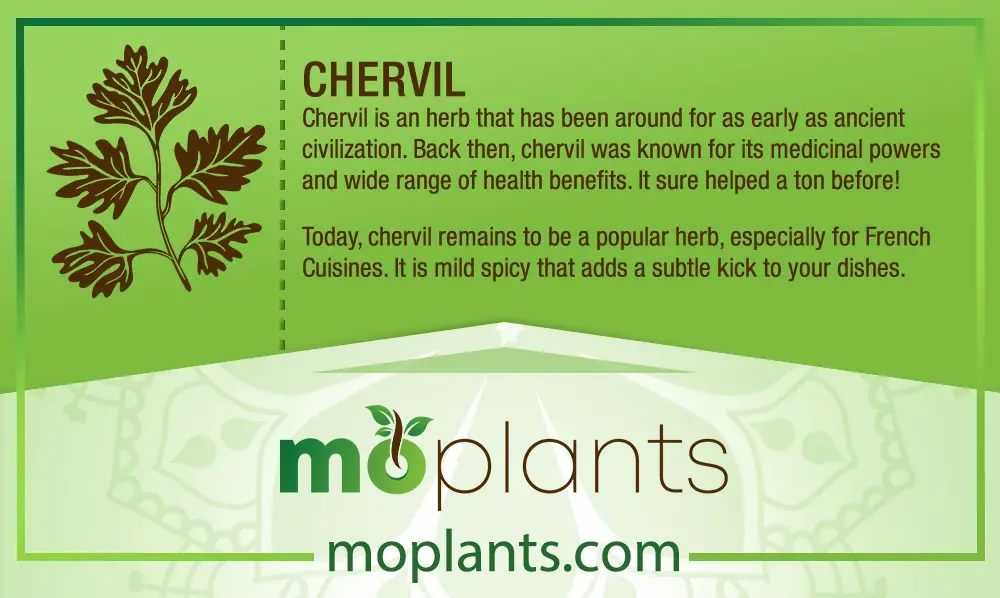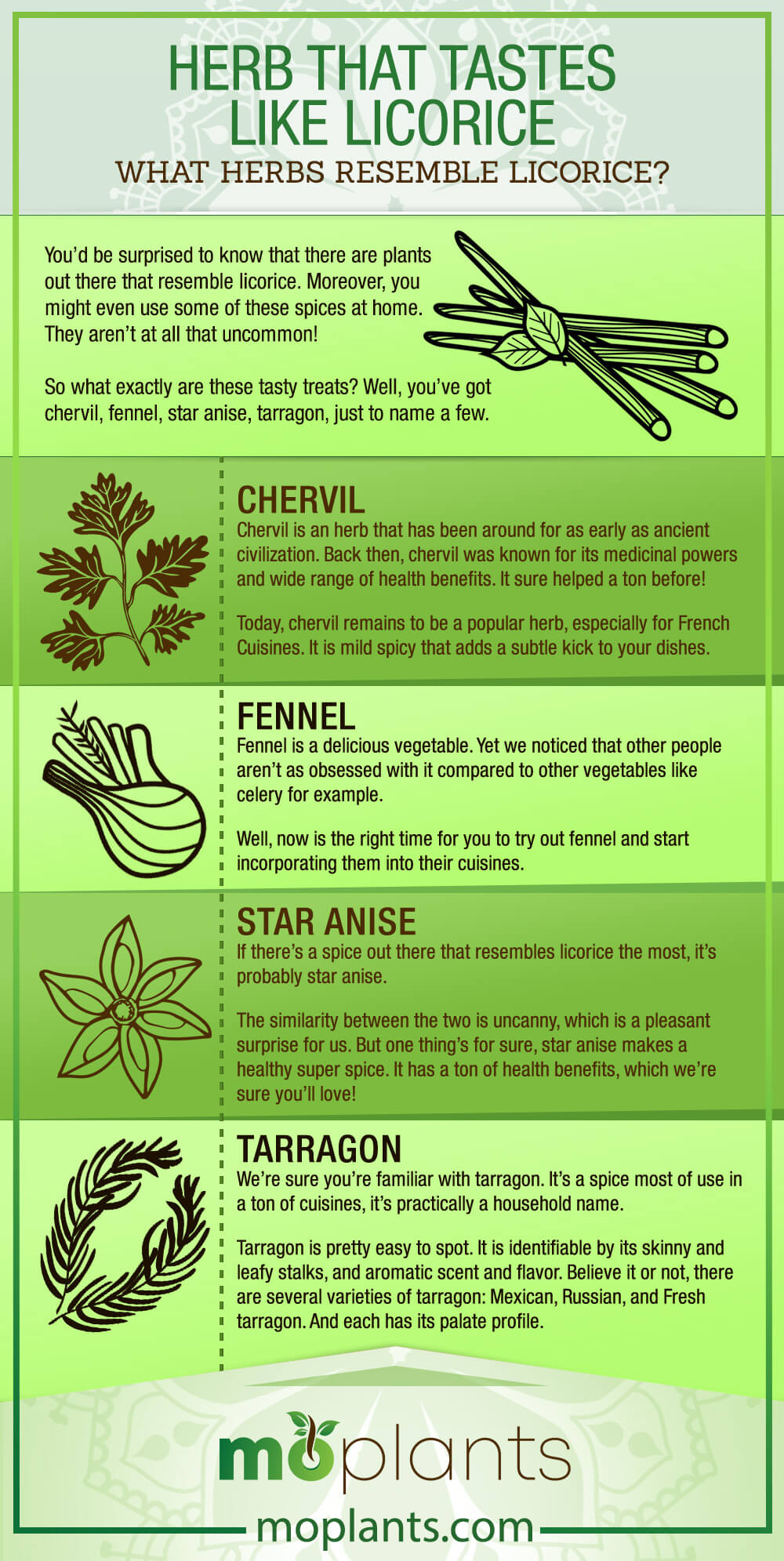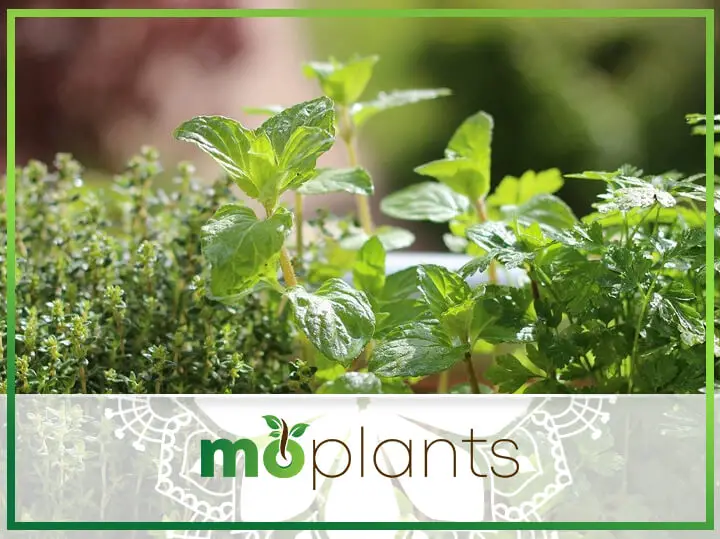Licorice: you either hate it or love it. It’s a combination of nearly all flavors, combining salty, sour, bitter, and sweet tasting. You name it!
Sure enough, licorice flavor can sometimes be considered an acquired taste. But once you get past the unique tastes, you won’t be able to get enough of it.
Today, we’ll go through spices that have a delicious licorice flavor. It’s a healthy alternative to the candied form that you can incorporate into your dishes.
What Herbs Resemble Licorice?
You’d be surprised to know that there are plants out there that resemble licorice. Moreover, you might even use some of these spices at home. They aren’t at all that uncommon!
So what exactly are these tasty treats? Well, you’ve got chervil, fennel, star anise, tarragon, just to name a few.
Chervil
Chervil is an herb that has been around for as early as ancient civilization. Back then, chervil was known for its medicinal powers and wide range of health benefits. It sure helped a ton before!
Today, chervil remains to be a popular herb, especially for French Cuisines. It is mild spicy that adds a subtle kick to your dishes.
What is Chervil?
The first thing you need to know about chervil is that it’s French Parsley.
Not many are familiar with chervil, especially since it’s mostly found in French cuisines. Nonetheless, using this herb for your meal every day can spice up your food.
Like most green leafy vegetables, you might confuse chervil with other green leafy vegetables.
Chervil has delicate light green colored curly leaves. The leaves look like those of parsley but having a paler and ruffled appearance.
What Is the Flavor Profile of Chervil?
If you haven’t tasted chervil before, imagine what anise tastes like.
Chervil shares the same palate as those two, although subtly and delicately. Others would even say that chervil is the milder version of parsley, tarragon, and fennel.
How to Enjoy Chervil?
Besides its medicinal purpose, chervil is a pretty neat spice to use. You can enjoy it in almost all cuisines, and it can definitely up the palate profile of your foods.
The French would commonly use chervil as an herb, incorporating it into their cuisines.
It has a distinct palate which they seem to enjoy. Whether they’re grilling fish or tossing salad, chervil remains to be that spice they’ll never let go of.
If you aren’t ready to incorporate chervil in your dishes just yet, you can try using it as a garnish for your soups and main course. Now, do note that chervil tastes better when used raw instead of cooking it.
Once you’ve gotten used to chervil, you might even want to consider using it as a rub for your food! It’ll give your dish a nice mild spice.

Fennel
Fennel is a delicious vegetable. Yet we noticed that other people aren’t as obsessed with it compared to other vegetables like celery for example.
Well, now is the right time for you to try out fennel and start incorporating them into their cuisines.
You can do many things with it, starting from fennel seeds, fennel stalks, and even the bulb. The possibilities are endless!
What Is Fennel?
The first thing you need to know about fennel is that they belong to the same carrot species.
A bit of a shocker right? Considering that fennel resembles nothing close to the orange members of the carrot family!
You can easily spot fennel from afar, thanks to its feathery leaf and round bulb.
You might even spot fennel flowers on the stalks if you’re lucky. Rest assured, each component of fennel is edible. Nothing goes to waste!
What Is the Flavor Profile of Fennel?
Like what was said earlier, you can eat the entire fennel plant. From fennel seeds down to the stalks! You can be creative with it and try incorporating each component in different cuisines!
The leaf and stalk have many uses, especially for making Italian salads. But if there’s one part of fennel that resembles star anise the most it’s the bulb.
The bulb is pretty savory, and you can easily enjoy eating it by simply chopping it up. Typically, a fennel bulb would be around the same size as a large onion, so you can have a ton of uses for it.
In general, fennel resembles star anise fruits. Whether you’re eating fennel raw or cooked, the anise flavor stands out.
But, we highly recommend that you try eating the bulb raw for you to appreciate the star anise flavor.
The texture resembles celery but with a licorice flavor. For us, fennel bulb makes a fine addition to our Italian salads.
How to Enjoy Fennel?
You can enjoy the fennel plant in different ways. And you’d be surprised to find that each fennel part tastes slightly different from each other but in a good way.
Starting with the fennel bulb, you can chop it up and saute it with your other vegetables. You can even roast the bulb in a pan and end up with delicious fennel wedges.
Now, you shouldn’t miss out on the delicious fennel stalks. The flowers and leafy green top makes a great garnish for your Italian salad, pasta, soups, among others.
You can even use the fennel seed or fennel stalks as the base for your soup! The celery texture adds a good crunch to your meal.

Star Anise
If there’s a spice out there that resembles licorice the most, it’s probably star anise.
The similarity between the two is uncanny, which is a pleasant surprise for us. But one thing’s for sure, star anise makes a healthy super spice. It has a ton of health benefits, which we’re sure you’ll love!
What Is Star Anise?
One thing’s for sure, star anise looks, unlike all the seeds and plants we’ve seen out there. Why? Well, it looks like a flowering plant instead of having green leafy stalks.
Believe it or not but star anise is a member of the parsley family.
Yet surprisingly, star abuse fruits resemble nothing close to these green leafy vegetables. More importantly, unlike leafy vegetables like celery, you don’t use the leaves of star anise!
Instead, it’s the anise seeds that you’d want to use from this plant.
Anise seeds are highly flavorful and have distinct tastes. Chinese cuisines usually use aniseed as their main source of spice and palate for some dishes.
What Is the Flavor Profile of Star Anise?
You can expect star anise to be sweet and salty.
Of all the vegetables out there, we can safely say that fennel and star anise are the two vegetables that closely resemble licorice.
And it’s probably because they all share the same compound called anethole. Anethole is the compound, where the flavor of star anise and fennel primarily comes from.
How to Enjoy Star Anise?
Star anise has a ton of uses! Vietnamese and Chinese cuisines use this spice to make the flavors of their food stand out.
If you’re new to using star anise, we highly recommend that you start with trying it out as a tea.
You can use dried star anise fruits for this, and pour hot water over it. Once the anise floats, you can take a sip and enjoy its complex and delicious tastes.
Once you’ve gotten used to the taste, you can use the seed for some of your meat-based dishes.
Do note that the seed is very potent, so you won’t be needing a ton of spices. A little goes a long way for star anise.

Tarragon
We’re sure you’re familiar with tarragon. It’s a spice most of use in a ton of cuisines, it’s practically a household name.
But did you ever notice how tarragon seems to have a close resemblance to the taste of licorice?
What is Tarragon?
Tarragon is pretty easy to spot. It is identifiable by its skinny and leafy stalks, and aromatic scent and flavor. Believe it or not, there are several varieties of tarragon: Mexican, Russian, and Fresh tarragon. And each has its palate profile.
What Is the Flavor Profile of Tarragon?
Truth be told, tarragon is one of those plants that you either love or not. It has a pretty diverse palate profile you need to try for yourself.
Yes, it has that bittersweet taste, but it also offers a lot more flavor. If you’re paying close attention, you’ll taste hints of mint, pepper, vanilla, and eucalyptus!
How to Enjoy Tarragon?
The beauty of using tarragon is that you can enjoy it fresh or dried. The fresh leaves are perfect as a garnish for any cuisine you plan to serve. You can even use it as a rub or marinade for some of your meats.
Dried tarragon is just as tasty as the fresh ones, although the flavor is a little subdued. So in essence, it’s a good spice to use for you to add a little oomph to your meal.

Infographic

Conclusion
Now that you know what plants have a delicious licorice taste, what else are you waiting for? It’s time to head straight to the kitchen and make yourself a healthy and delicious snack!
If you enjoyed all the info in this article, show us some love by hitting the like button below. If you have any more questions, feel free to leave them down in the comments section below.
You can also share this article with your friends and family! They’ll sure learn a ton of substance and information from this.

